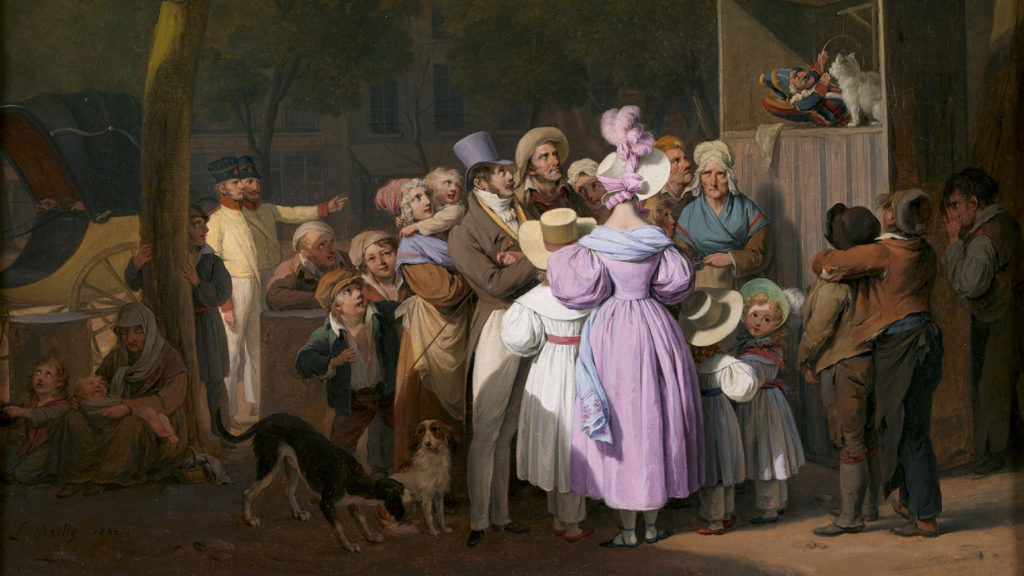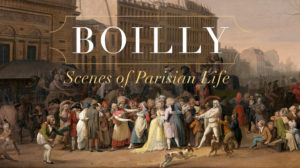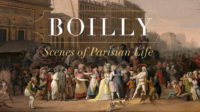Boilly: Scenes of Parisian Life at the National Gallery

The French painter currently on show at the National Gallery will be largely unknown to a British audience. Louis-Léopold Boilly lived through incredibly momentous times in his country’s history. Born in northern France, near Lille, in 1761, the artist moved to Paris in 1785 for his career when the Ancien Régime still reigned. By his 1845 death, he had lived through the Revolution, survived “The Terror” and seen the rise and fall of Napoleon Bonaparte, the restoration of the Bourbons and the July Monarchy.
This small exhibition – it comprises only 18 paintings in addition to some drawings and prints – has been mainly loaned by Ramsbury Manor in Wiltshire and is the first showing of the artist in a UK gallery. At the start, we see two erotic works which resulted in the painter’s appearance before the Committee of Public Safety during the Terror. One of these small paintings, Comparing Little Feet (circa 1791) shows two fashionably attired, upper-class young ladies in an elegant interior. Ostensibly they are removing their stockings and shoes to compare their delicate feet. In reality, the scene is an excuse for Boilly to tantalise. Both women are leaning forward, offering a glimpse of their décolletage. Even more risqué for the period is Two Young Women Kissing (circa 1790-4). Once again, two attractive young ladies appear in an interior. Here, however, there is no innocent comparing of dainty feet but a passionate kiss between the two women as their lips and bodies lock in ardour. Both were “cabinet paintings”, purely for male viewership. In 1794 Boilly was denounced by another artist, Jean-Baptiste Wicar, on the grounds that his work was a “revolting obscenity for Republican morals”. Luckily for the accused, he was able to talk his way out of his predicament and avoid the guillotine.
Boilly’s large oil painting, The Meeting of Artists in Isabey’s Studio (1798), proved pivotal to his career. The painter assembles his peers within a long room fashionably decorated with references to classical antiquity. He is promoting his fellow artists but also showing his characteristic savviness. The visiting public at the Salon greatly enjoyed matching the uncannily captured artists with the figures they saw in the exhibition venue. Boilly’s career benefited from the Revolution’s democratisation of art institutions such as the Salon and subsequent commercial opportunities.
After 1800, the subject became popular for his genre scenes of bourgeois and street life, showing everything from hilarity to hardship. Works such as The Little Chapel (circa 1803-4), and A Carnival Scene (1832) display his eye for detail and jewel-like palette. Boilly was chronicling the changing state of French society and the people who had become his patrons, the growing middle class.
The artist thrived as a portraitist of bourgeois customers. He boasted of being able to complete the pieces in only two hours, charging about 120 francs for small studies such as the charming Portrait of the Comtesse Francais de Sainte-Aldegonde (circa 1800-10). He also clearly enjoyed capturing his own bespectacled likeness, and that of his family.
Boilly’s business acumen is again highlighted at the end of this exhibition in his “trompe l’oeil” works. The artist is credited as the first to use the term, allotting a painting of that title at the 1800 Salon. His technical virtuosity impresses in A Girl at a Window (After 1799), a grisaille oil imitating a print. However, his illusionism astounds in A Trompe-L’Oeil Crucifix of Ivory and Wood (1812). One imagines a penitent reaching for the cross only to notice the cheeky painted note, where Boilly has added his name and address. It’s a terrific finale to an impressive show.
James White
Featured Image: Louis-Léopold Boilly, The Poor Cat, 1832
© Trustees of the Ramsbury Manor Foundation
Boilly: Scenes of Parisian Life is at the National Gallery from 28th February until 19th May 2019. For further information visit the exhibition’s website here.


























Facebook
Twitter
Instagram
YouTube
RSS